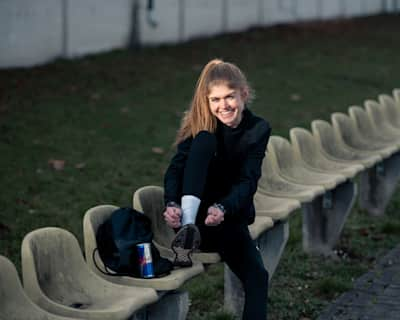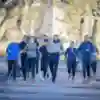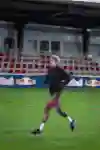
Running
Stretching exercises for runners: 7 to make you faster
Ahead of the Wings for Life World Run, track icon Koko Klosterhalfen shows you when and how you should stretch as a runner and which exercises are the most important.
Whether you're training for a triathlon, looking to nail a 10k in a city near you or preparing for an even such as the Wings for Life World Run, there's no better way to stay in shape than with stretches.
Or, maybe you're already a middle-distance and 5,000m running superstar, such as Konstanze 'Koko' Klosterhalfen, who credits her electric performances on the track with the right warmup and cool down. You're never too successful to do the basics.
So limber up, because the German athletics sensation is about to reveal a static stretching routine that could take your running to the next level. So sit back and let Klosterhalfen spill the secrets of her favourite stretches...
01
Stretch the calves
Start in a wide stride position with the weight on your front leg. From here push your hips and front knee forward, bringing your back heel towards the floor. Hold this stretch for up to 60 seconds and then switch sides.
02
Stretch the front of the thigh
Start in a hip-width stance with the upper body upright. Bring the heel of one leg back towards the buttocks and grasp the ankle with the arm on the same side. Pull the ankle as far towards the buttocks as possible, keeping the head, hips and knees in line. Hold this stretch for up to 60 seconds and then switch sides.
03
Stretch the back of the thigh
You can do this stretch either standing up or sitting on the floor. Sitting on the floor, stretch one leg straight out in front of you, bend the other leg sideways as shown in the picture and place the sole of your foot on the inside of your outstretched leg. Now slowly bring your upright upper body as far forward over the knee of your extended leg as you can - it may pull in the back of the thigh, but it must not hurt. Hold this stretch for up to 60 seconds and then switch sides.
04
Stretch hip flexors
Start in a deep lunge position. The back knee should be bent 90 degrees and touch the floor. The front knee must also be bent 90 degrees and in line with your ankle, upper body upright, spine straight. Now tense your gluteal muscles and at the same time push your hips forward and your back knee into the floor. Hold this stretch for up to 60 seconds and then switch sides.
05
The world's greatest stretch
Start in a hip-width stance. From here make a wide lunge backwards with your left leg. Then bring your left hand towards the floor with your arm outstretched and place your hand flat at about hip-width beside your right foot. Then bring your right elbow down towards your right foot as far as you can. You should feel a stretch in your right hip.
From here, rotate your upper body as far up to the right as possible. Your right arm should now be extended and pointing towards the ceiling. Your gaze should be on the fingers of your extended arm. Then return to the standing starting position and repeat the movement on the other side. Perform this stretch 10 times per side.
06
The scorpion
Start in a prone position with your chin resting on the floor and arms slightly apart beside your torso. Ensure your legs are stretched out and close together, toes touching the floor. Rotate your right leg from here to the left side of your body, trying to move your right foot towards your left hand. Your chin, chest and both shoulders should never lose contact with the floor. Then return your right foot to the starting position in a controlled manner and repeat the movement on the other side. Perform this stretch 10 times per side.
07
Stretch upper arms and shoulders
Runners should also stretch their arms regularly, as they're also subjected to a lot of strain during running and become more supple through regular stretching. Stretching the triceps and shoulders is particularly effective.
Triceps: start in a hip-width stance. Bring the hand of your right arm behind your head and towards your right shoulder blade. Support the onset of the triceps stretch by pulling your right elbow slightly further towards your head with your left hand. Hold this stretch for up to 60 seconds and then switch sides.
Shoulders: start in a hip-width stance. Bring your outstretched right arm parallel to the floor towards your left shoulder. Now reach under your extended right arm with your left arm and grasp your right shoulder with your left hand. Your right outstretched elbow should now rest on your left bent elbow. Now use your left arm to pull your right arm out so that you feel a stretch in your right shoulder. Make sure that you do not rotate your upper body. Hold this stretch for up to 60 seconds and then switch sides.
08
To stretch or not to stretch?
The experts at the Red Bull Athlete Performance Center in Thalgau, Austria, agree: stretching is a must and thinking otherwise should be out of the question for every athlete. In fact, stretching should be seen as a way of attaining muscle wellness. Used correctly, it can shorten recovery time, increase performance potential and also serve as injury prevention.
In short, the idea of stretching is to achieve the maximum range of movement of single or multiple muscles and joints.
"Everyone evaluates stretching differently. For me personally, stretching, used correctly, definitely makes sense," says Klosterhalfen. "It feels like this: if you're more mobile through regular stretching and your muscles are not so tight, you're more supple!"
And what runner wouldn't want to be more supple on the road? More supple in the mainly strained leg muscles, but also more supple in the upper body, according to Klosterhalfen. "When it comes to stretching, many runners only think of the benefits it has for the legs," she says. "But it also helps the upper body enormously. For example, if the upper body muscles aren't so tight, you can breathe much better."
09
The benefits of stretching at a glance
- Shortens the regeneration time
- Increases the performance potential
- Maximises range of motion in muscles and joints
- Serves as injury prevention
10
When to stretch and how?
This is the basic question: Is it about muscle relaxation or activation or mobilisation? What do you want to achieve with stretching? First, a runner must distinguish between two types of stretching - dynamic and static stretching.
In static stretching, you hold the stretch for up to 60 seconds in order to stretch the muscles gently. The aim is to reduce muscle tone, i.e. the tension in said muscles.
If, on the other hand, you want to go in the direction of activation and mobilisation, you should stretch dynamically. With dynamic stretching, you stretch the muscles for only a few seconds and, as the name suggests, you do it dynamically, through controlled swinging, for example.
"You shouldn't stretch too much before running," Klosterhalfen warns. "And if you do, then do it dynamically and briefly." The idea is not to stretch the muscles out, but to activate them, i.e. to prepare them for the load and to extend the range of motion in the joints. "After running, I personally always stretch longer and more statically," says Klosterhalfen. She also uses fascia rollers to roll out her legs after training, and a even a golf ball, which she uses every day to roll out the soles of her feet."
11
Don't forget the warm-up and cool-down
Every training session should start with an adapted warm-up and end with an appropriate cool-down. The activation (warm-up) should work around the following sub-areas:
- Small joint rotations (i.e. toes, ankle, knee, hip, spine, shoulders) starting with minor movements, increasing these slightly from rotation to rotation and making them more dynamic
- Activation of the cardiovascular system (start with low intensity but get that heart working)
- Terminal mobilisations of the ankle joints and the hip
- Acceleration runs (2 x 30-50 m) with 50m walking phases in between
This is followed by your actual training and then a cool-down adapted to it. This is about 'deceleration'. Specifically, you gradually reduce your running speed and end your training with a static stretching programme.
Part of this story















